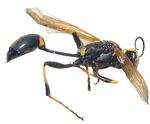
6 Important DIY Steps to Keep Wasps and Flies Out of Your Home
Want to know how to keep wasps and flies out of your home?
We have 6 easy DIY steps that can help you keep wasps and flies out of your home, and stop other even more destructive bugs from infesting your home this summer.
Here are some measures that keep wasps and flies out of our home:
- Wash fruit with vinegar water and keep it in the fridge. Fruit comes from all over the globe, and tends to have insect eggs and spores on it. I won’t bother you with the gory details, but you should really wash your fruit in water with a cup of vinegar. If you need to ripen some fruit, keep it in the shade on the back porch, not inside.
- Check and repair the loose and full open hidden openings to your house. Your dryer vent and fireplace damper are examples of loose openings. They close, but not tightly. You may wonder how to keep wasps from building nests in the chimney. Don’t rely on your fireplace damper to close your chimney tight enough to keep bugs or bats out. Install a wool Flueblocker or Chimney Balloon to seal it off super tightly. Clean the lint off flapper on the outside and make sure the hinge is working, so the flapper closes tightly when the dryer is off.Often a home builder will cut a hole in the wall of the home for a pipe or wires to come through, but they leave extra space around the hole. Use foam and caulk to close all of those penetrations in the homes envelope to keep wasps and flies out of your home as well as crawling bugs.
- Check the weatherstripping around your doors and put your porch lights on motion sensors. Weatherstripping keeps out the bugs, but it takes a beating over time as the door is used. It is very easy to replace weatherstripping with self-adhesive strips.Porch lights draw in flying and crawling bugs at night, and when you go through your door the mosquitoes and other bugs like a to hitch a ride into the house. Putting your lights on motion sensors limits the time your light it on, and keeps wasps and flies out of your home.

Sprayer to keep wasps and flies out of your home
- Keep shrubs from touching the side of your house and spray a boundary around your home. Keep your shrubs and other vegetation trimmed so it does not come in contact with your outer walls of your home. This will limit crawling bugs from getting in the walls. At the base of the walls spray a boundary spray. I use Taurus SC mixed into a garden sprayer, but you can use ready to spray kits like Ortho Home defense.Spray a 4″ to 6″ boundary on the base of the exterior wall all the way around the house and around each bottom level window. Give special attention to downspouts and any pipe or wire penetrations in the home envelope. Just be sure to follow the directions on the pesticide label.
- Trees are routes of bug entry too. Each year while I am on my roof cleaning the solar panels and scooping out the gutters, I use my bug boundary spray up there too. I spray the our edge of the roof deck by the gutters, and around any vents that come through the roof. I also spray the crown of my fireplace chimney and around the cap. This helps to keep wasps and flies out of your home, since they love to follow cooking smells down the chimney.
- Lets talk termites. If you live in an area with termites (like I do in SC) then you need to take them seriously. They can get inside of any house, and you wont even see their entry point since they are subterranean. Every 7 years I do a termite trench with Dominion 2L all the way around my home. Termite trenching is when you dig a 6″ trench line at the base of your outside wall you saturate the dirt with termiticide and put it back in the trench.
It is hard to keep wasps and flies out of your home, as well as ants, termites, cockroaches, spiders, etc… but it is worth the effort.
